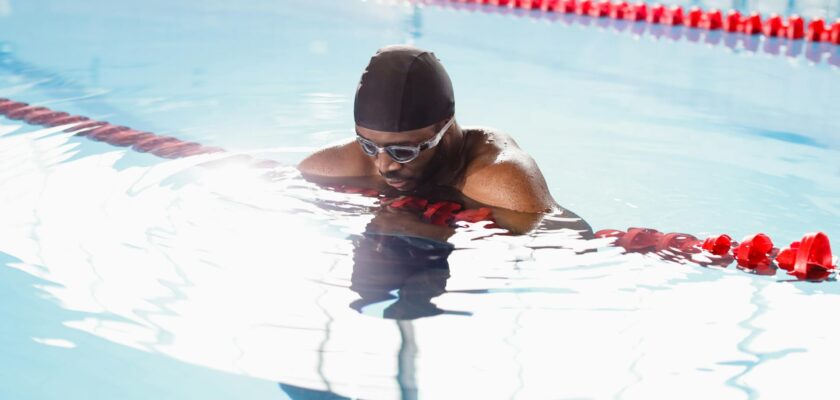Don’t hesitate: in this article, we’ve put together everything about paralympic swimming so you can get to know this sport responsible for so many inspiring stories.
Swimming is already famous: you probably know it or have even practiced it. Paralympic swimming follows the same logic, except that it is a sport adapted for athletes with physical disabilities.
There’s no secret to it: just as in conventional swimming, competitors swim in pools with the aim of completing specific distances in the shortest possible time.
In order to ensure that athletes with different types and levels of disability can compete fairly, there is a whole classification system that we’ll show you in detail below.
Participate in our free WhatsApp community and receive daily tips, news and trivia from over 50 sports! Click here to join.
How does paralympic swimming work?
Paralympic swimming is governed by the International Paralympic Committee (IPC) and is an integral part of the Paralympic Games, which always take place after the Olympic Games. It takes place in much the same way as traditional swimming.
Paralympic swimming includes a variety of swimming styles, such as crawl, backstroke, breaststroke and butterfly, as well as relay races. Athletes can compete in individual and team events.
As well as promoting competition and sporting performance, Paralympic swimming plays an important role in breaking down barriers and stigmas in relation to people with disabilities.
All about paralympic swimming: history
Paralympic swimming has been included in the Paralympic Games since its first official edition in 1960 in Rome, Italy. Since then, the sport has become an integral part of the competition, gaining prominence and growing in popularity over the years.
Over the decades, Paralympic swimming has experienced significant growth in terms of the number of participants, levels of competition and public recognition.
This meant new training techniques, adapted equipment technologies and specific rules to ensure a fair and inclusive competition.
We can currently consider Paralympic swimming to be one of the most popular disciplines at the Paralympic Games around the world.
All about paralympic swimming: classes
According to the Brazilian Paralympic Committee, Paralympic swimming is divided into classes according to the type of swimming and the athlete’s degree of disability – who can have physical, visual or intellectual disabilities.
To understand: the paralympic swimming class has a letter and a number. The letter stands for the type of swimming, and the number for the degree of impairment and/or functionality. Classes always start with the letter S (for swimming). So it looks like this:
- S + athlete’s class number (freestyle, backstroke and butterfly);
- SB + athlete’s class number (breaststroke);
- SM + athlete’s class number (medley swimming).
To be classified, the athlete takes part in an analysis (which we’ll explain later). The fact is that the greater the disability, the lower the class number. In other words: the greater the degree of impairment, the lower the class number.
- Classes 1 to 10: athletes with physical-motor limitations
- Classes 11 to 13: visually impaired athletes
- Class 14: athletes with intellectual disabilities
All about paralympic swimming: rankings
Regarding the classification process in Paralympic swimming, the aim is for athletes to be competing in appropriate classes according to their physical and functional abilities.
Muscle residue analysis
Muscle residue analysis involves assessing the athlete’s muscle and joint functions to determine the impact of their impairment on swimming practice. Here are some key points of this analysis:
Muscle strength tests
Athletes also perform muscle strength tests to assess their muscles’ ability to generate force. This can include endurance or maximum strength tests on different muscle groups relevant to swimming.
Joint mobility
The classification team checks the athlete’s joint mobility, assessing the range of movement of the joints. This helps determine which movements can be performed efficiently while swimming.
Water motor tests
These tests are carried out in the water to observe how the athlete’s disability affects their swimming performance. This can include observation of swimming technique, efficiency of movement and propulsion capacity in the water.
Functional assessment
In addition to the physical tests, the classification team can also carry out a broader functional assessment to understand how the athlete’s disability affects their athletic and functional abilities.
All about paralympic swimming: top athletes
The paralympic swimmers represent overcoming and diversity. Meet the biggest names:
Daniel Dias (Brazil)
One of the most successful Paralympic swimmers in history. He competed in several Paralympics and won numerous gold medals in events such as the 50m and 100m freestyle, 50m butterfly and 200m medley.
Teresa Perales (Spain)
A Spanish Paralympic swimmer who has won a large number of medals at various Paralympics. She competes in a variety of styles and distances, including freestyle, backstroke and butterfly.
André Brasil (Brazil)
André Brasil is another outstanding Brazilian Paralympic swimmer. He has competed in several Paralympics and won medals in events such as the 100m and 200m freestyle, 100m butterfly and 100m backstroke.
Jessica Long (United States)
Jessica Long is a paralympic swimmer from the United States known for her versatility and success in several Paralympics. She competes in a variety of styles and distances, winning numerous gold medals throughout her career.
Clodoaldo Silva (Brazil)
Clodoaldo Silva, known as the “Paralympic Shark”, is a Brazilian swimmer who has won multiple Paralympic gold medals. He specializes in freestyle and butterfly events.
Now that you know everything about paralympic swimming and can consider yourself a true expert, how about continuing on our website to learn even more about the world of sports? Check out our content:



